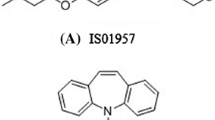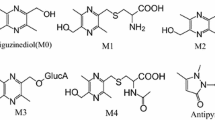Abstract
Camptothecin bile acid analog (A2) is a camptothecin derivative, which has been verified to possess the high anti-tumor activity. The purpose of this study was to develop an effective and sensitive detection method to investigate the pharmacokinetics, tissue distributions and the bioavailability in rat plasma and other organs for the further understanding of A2. The standard curves, control samples and quality control samples were prepared by blank plasma and tissues of non-administered mice at 4 °C for HPLC–MS/MS analysis. The method validation was carried out on the five different occasions (specificity and selectivity, linearity, accuracy and precision, extraction recovery and matrix effects, and stability). The pharmacokinetic analysis showed that A2 showed twice absorption at 1 h and 4 h after oral administration and the second absorption was stronger than the first absorption. A2 was distributed mainly in the intestine and spleen. A2 had great oral bioavailability and the potential targeting property, indicating that CPT coupled to bile acid groups helped to improve bioavailability by bile acid transporters. These results would promote the development of camptothecin-bile acid analogue.
Access this article
We’re sorry, something doesn't seem to be working properly.
Please try refreshing the page. If that doesn't work, please contact support so we can address the problem.





Similar content being viewed by others
Availability of Data and Materials
Considered upon request. Further information is available from the corresponding author on reasonable request.
Code Availability
Not applicable.
References
Umar AB, Uzairu A, Uba S, Shallangwa GA (2020) QSAR and docking studies on some potential anti-cancer agents to predict their effect on M14 melanoma cell line. Chem Afr 3(4):1009–1022. https://doi.org/10.1007/s42250-020-00185-w
Bacherikov VA (2022) Total synthesis, mechanism of action, and antitumor efficacy of camptothecin and some of its analogues. Anticancer Agents Med Chem 22(20):3438–3465
Behera A, Padhi S (2020) Passive and active targeting strategies for the delivery of the camptothecin anticancer drug: a review. Environ Chem Lett 18(5):1557–1567. https://doi.org/10.1007/s10311-020-01022-9
Fan S, Cao Y, Li G, Lei H, Attiogbe M, Yao J et al (2020) F10, a new camptothecin derivative, was identified as a new orally-bioavailable, potent antitumor agent. Eur J Med Chem 202:112528. https://doi.org/10.1016/j.ejmech.2020.112528
Martin-Encinas E, Selas A, Palacios F, Alonso C (2022) The design and discovery of topoisomerase I inhibitors as anticancer therapies. Expert Opin Drug Discov 17(6):581–601. https://doi.org/10.1016/j.ejmech.2020.112528
Talukdar A, Kundu B, Sarkar D, Goon S, Mondal MA (2022) Topoisomerase I inhibitors: challenges, progress and the road ahead. Eur J Med Chem 236:114304. https://doi.org/10.1016/j.ejmech.2022.114304
Wang J, Wang K, Han T, Li J, He X, Rong R et al (2020) Antitumour properties based on the self-assembly of camptothecin and carbamoylmannose conjugates. Chem Biol Drug Des 96(2):870–877. https://doi.org/10.1111/cbdd.13698
Khaiwa N, Maarouf N, Darwish M, Alhamad D, Sebastian A, Hamad M et al (2021) Camptothecin’s journey from discovery to WHO Essential Medicine: Fifty years of promise. Eur J Med Chem 223:113639. https://doi.org/10.1016/j.ejmech.2021.113639
Xiao L, Yu E, Yue H, Li Q (2019) Enhanced liver targeting of camptothecin via conjugation with deoxycholic acid. Molecules 24(6):1179. https://doi.org/10.3390/molecules24061179
Deng F, Bae Y (2020) Bile acid transporter-mediated oral drug delivery. J Control Release 327:100–116. https://doi.org/10.1016/j.jconrel.2020.07.034
Shulpekova Y, Shirokova E, Zharkova M, Tkachenko P, Tikhonov I, Stepanov A et al (2022) A recent ten-year perspective: bile acid metabolism and signaling. Molecules 27(6):1983. https://doi.org/10.3390/molecules27061983
Dhibar S, Ojha SK, Karmakar K, Karmakar P, Bhattacharjee S, Chatterjee P et al (2023) Development of supramolecular metallogel derived from Nickel(II)-salt and adipic acid: an effective material for microelectronic semiconducting device application. Chem Afr. https://doi.org/10.1007/s42250-023-00680-w
Gaowa A, Horibe T, Kohno M, Kawakami K (2018) Bile acid as an effective absorption enhancer for oral delivery of epidermal growth factor receptor-targeted hybrid peptide. J Pharm Sci 107(5):1322–1329. https://doi.org/10.1016/j.xphs.2017.12.012
Enright E, Griffin B, Gahan C, Joyce S (2018) Microbiome-mediated bile acid modification: role in intestinal drug absorption and metabolism. Pharmacol Res 133:170–186. https://doi.org/10.1016/j.phrs.2018.04.009
Li X, Zhao T, Cheng D, Chu C, Tong S, Yan J et al (2014) Synthesis and biological activity of some bile acid-based camptothecin analogues. Molecules 19(3):3761–3776. https://doi.org/10.3390/molecules19033761
Li Q, Gao Y, Qiu W, Zu Y, Su L, He W et al (2011) Synthesis and anti-tumour activity of novel camptothecin-bile acid analogues. Lett Drug Des Discov 8(8):698–703
Li G, Cai C, Qi Y, Tang X (2016) Hydroxyethyl starch-10-hydroxy camptothecin conjugate: synthesis, pharmacokinetics, cytotoxicity and pharmacodynamics research. Drug Deliv 23(1):277–284. https://doi.org/10.3109/10717544.2014.911394
Wang W, Shen Q, Liang H, Hua C, Liu Y, Li F et al (2016) Pharmacokinetic studies of novel berberine derivatives with ultra-performance liquid chromatography-tandem mass spectrometry. J Chromatogr B Analyt Technol Biomed Life Sci 1031:172–180. https://doi.org/10.1016/j.jchromb.2016.07.038
Xiao L, Xu J, Weng Q, Zhou L, Wang M, Liu M et al (2019) Mechanism of a novel camptothecin-deoxycholic acid derivate induced apoptosis against human liver cancer HepG2 cells and human colon cancer HCT116 cells. Recent Pat Anticancer Drug Discov 14(4):370–382
Li Q, Zhu Q, Zhang X, Hua C, Deng X, Zhao T et al (2013) A liquid chromatography-tandem mass spectrometry method for pharmacokinetics and tissue distribution of a camptothecin quaternary derivative in rats. Fitoterapia 90:57–64. https://doi.org/10.1016/j.fitote.2013.06.012
Zheng J, Ji Y, Shao C, Jing L, Wang Y (2018) Pharmacokinetics and tissue distribution study of 10-methoxycamptothecin in rats following intragastric administration. J Pharm Biomed Anal 149:564–571. https://doi.org/10.1016/j.jpba.2017.11.062
Xiao L, Zhou Y, Zhang X, Ding Y, Li Q (2019) Transporter-targeted bile acid-camptothecin conjugate for improved oral absorption. Chem Pharm Bull (Tokyo) 67(10):1082–1087. https://doi.org/10.1248/cpb.c19-00341
Wang Z, Shao C, Hu Z, Zheng J, Zhang Q, Kou H et al (2020) The development and validation of an LC-MS/MS method for the quantification of CZ112, a prodrug of 9-Nitrocamptothecin in rat plasma. J Pharm Biomed Anal 179:112963
Funding
This work was supported by the China Postdoctoral Science Foundation (2022M712823), National Natural Science Foundation of China Grant (31270397) and Qianjiang talents projection Zhejiang province.
Author information
Authors and Affiliations
Contributions
WW, XL, LA, RW and XH performed the research and interpreted the data. Preparation of the initial manuscript was carried out by WW, QL and LA. The manuscript was revised and approved by LA, RW, HX, XH, LH, XH and YQ, HW and QL contributed to the interpretation of the data and the writing and reviewing the manuscript. WW, LA, XH and LH contributed to the analysis and interpretation of the data.
Corresponding author
Ethics declarations
Conflicts of Interest
Confirm that there are no related financial or non-financial competing interests that need to be declared. The authors declare no conflicts of interest in this work.
Ethics Approval
Adult Sprague Dawley (SD) rats (female) weighting 200–220 g were obtained from the Laboratory Animal Center of Zhejiang Academy of Medical Sciences (Hangzhou, China; License No. SCXK [Zhe] 2019–0002). All animals were raised in a dedicated area with the room temperature and relative humidity kept at 25 ± 1 °C and 50%, respectively, and would adapt to the barrier environment for a week before treatment. All experiments were approved by the laboratory animals ethical committee of the Zhejiang University of Technology. The applied procedures comply with the ARRIVE guidelines and were carried out in accordance with the National Institutes of Health guide for the care and use of Laboratory animals (NIH publication No. 85–23, revised 1996). Rats were fasted overnight with free access to water before the experiment.
Consent for Publication
Not applicable.
Consent to Participate
Not applicable.
Supplementary Information
Below is the link to the electronic supplementary material.
Rights and permissions
Springer Nature or its licensor (e.g. a society or other partner) holds exclusive rights to this article under a publishing agreement with the author(s) or other rightsholder(s); author self-archiving of the accepted manuscript version of this article is solely governed by the terms of such publishing agreement and applicable law.
About this article
Cite this article
Wang, W., Li, X., An, L. et al. An Effective and Sensitive HPLC–MS/MS Method for Determination of Cholic Acid-Coupled Camptothecin Derivative A2 in Rat Pharmacokinetics and Tissue Distribution. Chemistry Africa 7, 1373–1383 (2024). https://doi.org/10.1007/s42250-023-00846-6
Received:
Accepted:
Published:
Issue Date:
DOI: https://doi.org/10.1007/s42250-023-00846-6




